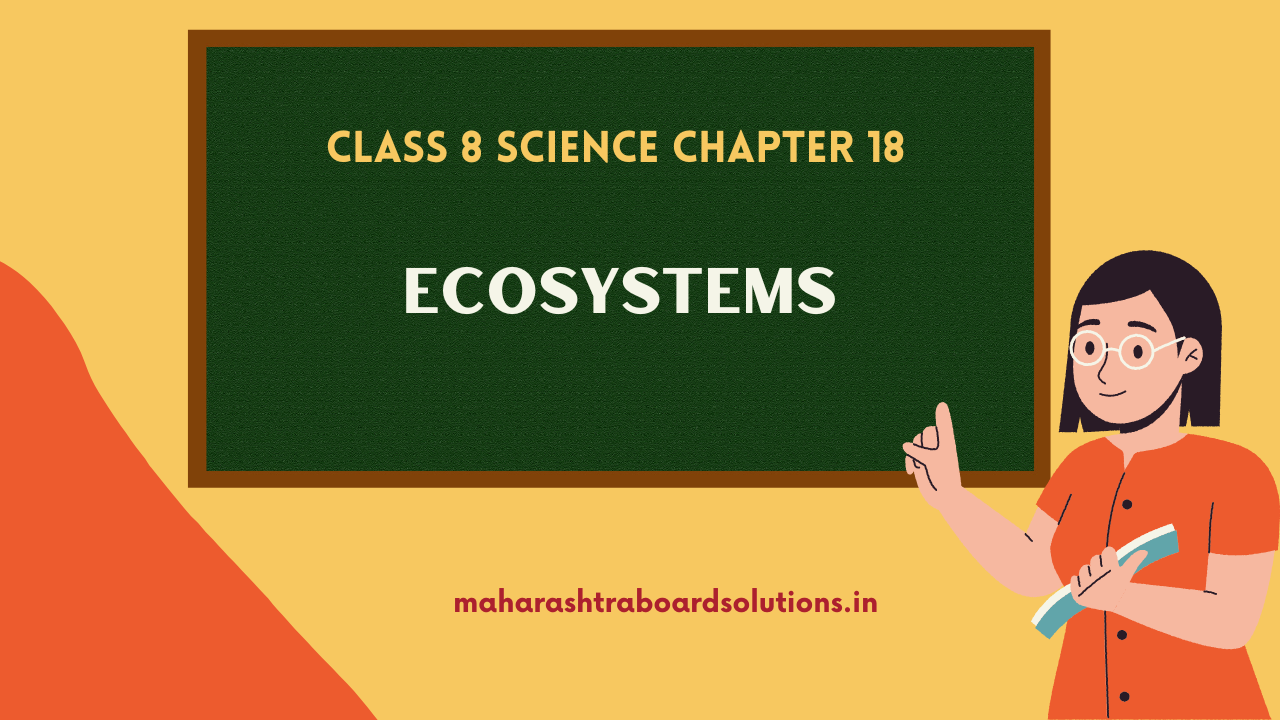Balbharti Maharashtra State Board Class 8 Science Solutions Chapter 18 Ecosystems Notes, Textbook Exercise Important Questions and Answers.
Std 8 Science Chapter 18 Ecosystems Question Answer Maharashtra Board
Class 8 Science Chapter 18 Ecosystems Question Answer Maharashtra Board
1. Complete the following by using the correct option:
Question a.
Air, water, minerals, soil are ………….. factors of an ecosystem. (physical, organic, inorganic)
Answer:
Air, water, minerals, soil are physical factors of an ecosystem.
Question b.
River, ponds, ocean are …………. ecosystems, (land, aquatic, synthetic)
Answer:
River, ponds, ocean are aquatic ecosystems.
![]()
Question c.
Man is ………….. in an ecosystem. (producer, consumer, decomposer)
Answer:
Man is consumer in an ecosystem.
2. Match the following:
Question a.
| Producer | Ecosystem |
| 1. Cactus | a. Forest |
| 2. Aquatic plants | b. Creek |
| 3. Mangroves | c. Aquatic |
| 4. Pine | d. Desert |
Answer:
| Producer | Ecosystem |
| 1. Cactus | d. Desert |
| 2. Aquatic plants | c. Aquatic |
| 3. Mangroves | b. Creek |
| 4. Pine | a. Forest |
![]()
3. Give my information:
Question a.
Ecosystem.
Answer:
Ecosystem is the structure formed by the interrelationships between the living organisms and non-living components in their surrounding habitats. Living organisms are also called biotic factors while the non-living components are called abiotic factors. The abiotic and biotic factors have a reciprocal relationship with each other. The ecosystem has plants as producers, animals as consumers and microbes as decomposers.
The decomposers return the substances back to the nature by process of decomposition in which the organic complex molecules are reduced to their inorganic constituents. Thus the dead remains of plants and animals are once again recycled back to the nature in any healthy ecosystem.
Question b.
Biome.
Answer:
Biomes are a larger collection of small ecosystems which are similar in their structure. In a particular biome there are same climatic, abiotic factors and similar living organisms. Biomes are of two main types, land biomes and aquatic biomes. The land biomes exist only on land. Land biomes are of following subtypes based on the abiotic factors. E.g. Grasslands, evergreen forests, deserts, Tundra ecosystem, ecosystems in Taiga, tropical rainforests, etc. Aquatic biomes include freshwater ecosystem, marine ecosystem and brackish water ecosystem found in the creeks.
![]()
Question c.
Food web.
Answer:
The complex feeding relationships form a food web. In nature in any ecosystem, the food chains are not straight and linear. But these are quite complex. A prey is consumed by a predator but this predator can itself be a prey to some other predator. E.g. Frog is a predator for variety of insects but frog is preyed upon by snake and the snake can be eaten by a bird. The same bird can also feed on insects or frog. The interrelationships between different biotic components of any ecosystem thus form the complicated food web.
4. Give scientific reasons:
Question a.
Plants in an ecosystem are called producers.
Answer:
are cut down causing deforestation. The wild animals lose their habitat. Many of them become extinct. There is great loss of flora and fauna due to construction of large dams. There is undue pressure on the land surface caused due to stored water column. This may cause earthquakes. The human settlements are removed as their houses and farms are immersed under water. In all the above ways large dams destroy the ecosystems.
Question b.
Large dams destroy ecosystems.
Answer:
When a large dam is constructed, the original landscape is changed. The trees are cut down causing deforestation. The wild animals lose their habitat. Many of them become extinct. There is great loss of flora and fauna due to construction of large dams. There is undue pressure on the land surface caused due to stored water column. This may cause earthquakes. The human settlements are removed as their houses and farms are immersed under water. In all the above ways large dams destroy the ecosystems.
Question c.
Rhinos were restored in Dudhwa forest.
Answer:
Long ago in last century, Dudhwa forest was the natural habitat of the one-horned Rhino. However, due to hunting and poaching, the Rhino became almost extinct. In order to restore it back the breeding in captivity was attempted and the young ones were released in the natural habitat. Saving the precious wildlife is important and hence these efforts were done.
![]()
5. Answer the following:
Question a.
What are the effects of increased population (of human beings) on ecosystems?
Answer:
- Human population growth rate is very big as compared to other animals.
- Moreover, they are apex consumers in an ecosystem. Just like any other organisms, ecosystems provide all the basic needs to humans, too.
- However, man demands much more due to excessive population. The natural resources are utilized on the large scale only by man.
- Changing lifestyles, consumerism, degradation of nature and pollution are certain aspects which are created only by human beings.
- All these cause increased stress on the ecosystems. Large human population also produces large-scale solid wastes.
Question b.
How is urbanization responsible for destruction of ecosystems?
Answer:
When people do not get sufficient food and other amenities, they migrate to the cities. The cities provide employment for many people due to industries, factories and other facilities. Every day many people migrate to cities. This causes urbanization. Due to increased population in cities, there is more need for housing. This results in loss of agricultural lands, marshlands, wetlands, forests and grasslands, etc.
The natural ecosystems are lost in an attempt to have developmental work. Human interference causes changes in the ecosystems. When land usage is changed many naturally occurring species of plants and animals are exterminated. Animal- human conflicts are very common in newly established urban areas which are near the natural forests.
![]()
Question c.
What are the reasons for war?
Answer:
There are difference of opinions and competition over land, water, mineral resources, etc. among neighbouring countries. Moreover, there can be economic and political causes which lead to war among different countries. Many times the l religions and ethnicity are also caused for dispute. Due to international conflicts, the peace is disturbed and it results in war.
Question d.
Explain the interactions among the factors of an ecosystem.
Answer:
- The abiotic factors such as air, water, soil, sunlight, temperature, humidity, etc. affect the biotic factors, i.e. the surviving plants, animals and microbes in the ecosystem.
- The type of abiotic factors in an ecosystem determine the survival of biotic factors. The population of these biotic factors is also dependent on the quality of abiotic factors.
- The proportion of abiotic factors in an ecosystem fluctuates as biotic factors use up or release particular abiotic factors.
- Every biotic factor also interacts with its necessary abiotic factors as well as other biotic factors around it.
Question e.
Differentiate between evergreen forests and grasslands.
Answer:
| Evergreen forests | Grasslands |
| 1. About seven percent of the Earth’s surface is occupied by evergreen forests. | 1. About 30 percent of the Earth’s surface is covered by grasslands. |
| 2. More than half of the earth’s terrestrial plants and animals are seen in evergreen forests. | 2. Grazing animals are seen in grasslands. |
| 3. Tropical evergreen forests are dense, multi-layered. | 3. Grasslands consist of tall grass. There are wild grasses and there may be some trees. |
| 4. These forests are found in the areas receiving more than 200 cm annual rainfall i.e. very heavy rainfall. | 4. There is an average of 20 – 35 inches of rainfall a year in grasslands. |
| 5. Tropical regions show evergreen forests. | 5. Several parts of the world have grasslands. |
![]()
6. Describe the following pictures:
Question a.
Describe the following pictures
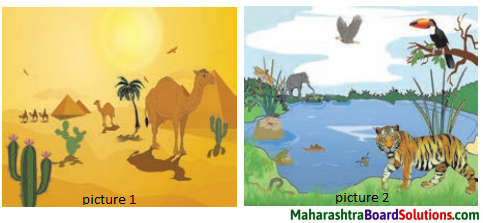
Answer:
The picture no. 1 is showing desert ecosystem, while the picture no. 2 is showing a forest ecosystem where a wetland (a lake) is also shown. In desert ecosystem, the producers are green cactus and a palm tree. Since in desert there are scanty rains, the vegetation is very less. The soil is sandy soil. The consumers of the desert are also limited.
In the above picture camel is shown which is a primary consumer in the desert ecosystem. Camel is very well adapted for desert life. There is also the scarcity of water in desert and hence cactus shows xerophytic (suitable to survive in desert) adaptations.
In second picture, the forest ecosystem is shown because we can see elephant and tiger in the picture. Also, giant hornbill is sitting on the tree. This forest must be tropical evergreen forest. The rainfall is heavy in such areas and hence different types of wetlands can be seen in forests. Wetlands support variety of life. A separate aquatic ecosystem does exist here which is closely interconnected with the terrestrial ecosystems through food chains and food web.
The birds utilize the fish as their prey. The wild animals come to wetlands to quench their thirst. In this picture the plants, grass, etc. are producers, small fishes in the lake are primary consumers. They will be eaten by larger fishes which are secondary consumer in the aquatic ecosystem. The elephant is herbivorous animal and hence it is primary consumer. Snake is the secondary consumer while the birds of prey (eagle that is flying) and tiger are tertiary consumers.
![]()
Can you recall?
Question 1.
Which factors do you find in your surroundings?
Answer:
In our surroundings there are abiotic and biotic factors. The biotic factors are animals and plants in the surroundings. The invisible bacteria and fungi also have important role in the ecosystem as decomposers. Important abiotic factors are air, water, land, sunlight, etc.
Question 2.
Are these factors directly or indirectly related to you?
Answer:
We are directly or indirectly connected to every single factor in the surrounding in which we reside. For the requirement of food, we are dependent on plants and animals. For our survival we continuously need oxygen, water and other minerals, etc.
Classify:
Question 1.
Classify the following into living and non-living factors. Sunlight, Sunflower, Elephant, Lotus, Algae, Stone, Grass, Water, Ant, Soil, Cat, Fern, Air, Lion.
Answer:
| Living Factors | Non-living Factors |
| Sunflower, Elephant, Lotus, Algae, Grass, Ant, Cat, Fern, Air, Lion. | Sunlight, Stone, Water, Soil, Air. |
Can you tell?
Question 1.
What is the role of microbes in above interaction?
Answer:
Microbes play the role of decomposers in the above interactions.
![]()
Question 2.
How do producers obtain abiotic factors?
Answer:
Producers obtain solar energy from sunlight. The other nutrients are obtained from soil, water and air.
Question 3.
From where do the consumers get their food?
Answer:
Consumers get their food from producers and other consumers.
Project:
Question 1.
Visit an ecosystem nearby, List the biotic and abiotic factors in it. Show with pictures or sketches, how they are dependant on each other.
Question 2.
With the help of internet find out the loss of ecosystems due to wars or atomic explosions. Describe in your words.
Class 8 Science Chapter 18 Ecosystems Important Questions and Answers
Complete the following by using the correct option:
Question 1.
Biotic community is another name for ………. (ecology, ecosystem, population)
Answer:
Biotic community is another name Biotic for ecosystem.
![]()
Question 2.
Microbes in an ecosystem are ………… (producers, consumers, decomposers)
Answer:
Microbes in an ecosystem are decomposers.
Question 3.
Many types of ecosystems are found in ………… (oceans, deserts, biosphere)
Answer:
Many types of ecosystems are found in biosphere.
Question 4.
………….. is a type of grassland ecosystem. (Taiga, Tundra, Desert)
Answer:
Taiga is a type of grassland ecosystem.
Question 5.
Gir forest in Gujarat is the only habitat/shelter for the spectacular ………….. (Asiatic lion, Royal Bengal tiger, One-horned rhino)
Answer:
Gir forest in Gujarat is the only habitat shelter for the spectacular Asiatic lion.
Correct the following statements by changing one or two words:
Question 1.
Primary, secondary, tertiary consumers are the abiotic factors of the ecosystem.
Answer:
Primary, secondary, tertiary consumers are the biotic factors of the ecosystem.
Question 2.
Most of the ecosystems are simple.
Answer:
Most of the ecosystems are complex.
![]()
Question 3.
The word ecosystem was brought in the use by Ray Claffam.
Answer:
The word ecosystem was brought in the use by A.G. Tansle.
Question 4.
Specific ecosystem developed in a vast area is called a biosphere.
Answer:
Specific ecosystem developed in a vast area is called a biomes.
Question 5.
Longer summer and limited rain develop very tall plants in the grassland ecosystem.
Answer:
Longer summer and limited rain develop dwarf plants in the grassland ecosystem.
Question 6.
29 % of the earth surface is covered by water and only 71 % has land on it.
Answer:
71 % of the earth surface is covered by water and only 29 % has land on it.
![]()
Question 7.
Dams increase the water current in lower area.
Answer:
Dams lessen the water current in lower area.
Match the following:
Question 1.
| Column ‘A’ | Column ‘B’ |
| 1. The Great Himalayan National Park | a. Asiatic lion |
| 2. Kaziranga | b. Tigers |
| 3. Bharatpur | c. Aquatic birds |
| 4. Ranthambore | d. One-horned Rhino |
| 5. Gir forest | e. White panther |
Answer:
| Column ‘A’ | Column ‘B’ |
| 1. The Great Himalayan National Park | e. White panther |
| 2. Kaziranga | d. One-horned Rhino |
| 3. Bharatpur | c. Aquatic birds |
| 4. Ranthambore | b. Tigers |
| 5. Gir forest | a. Asiatic lion |
Find the odd one out:
Question 1.
Typha, Pistia, Eichhornia, Dipterocarpus
Answer:
Dipterocarpus. (All others are aquatic plants.)
Question 2.
Teak, Parthenium, Pine, Sandalwood
Answer:
Parthenium. (All others are forest trees.)
![]()
Question 3.
Giraffe, Zebra, Cheetah, Elephant
Answer:
Cheetah.. (All others are surviving grassland animals, Cheetah is a forest animal that is extinct from Asia.)
Question 4.
Hyena, Cow, Deer, Rabbit
Answer:
Hyena. (All others are primary consumers, Hyena is tertiary consumer.)
Question 5.
Fusarium, Leptocorsia, Aspergillus, Polycarpus
Answer:
Leptocorsia. (All others are decomposers, Leptocorsia is primary consumer.)
Taking into consideration the relationship in the first pair, complete the second pair :
Question 1.
Plants : Producers : : ……… : Consumers
Answer:
Animals
Question 2.
Secondary consumers : Jackals : : Tertiary consumer : ………..
Answer:
Kite/Lion/Hyena
Question 3.
Goat, sheep : Grassland ecosystem : : Tigers : …………..
Answer:
Forest ecosystem
![]()
Question 4.
Desert : Land biome : : Creek : …………….
Answer:
Aquatic biome
Question 5.
Limited rain : Grassland ecosystem : : ……….. : Tropical rainforests
Answer:
Excessive rain.
Answer in one sentence:
Question 1.
What is an ecosystem?
Answer:
The structure which is formed due to interactions between abiotic and biotic factors is called an ecosystem.
Question 2.
What is an ecological niche?
Answer:
The position of any living organism with reference to other living organisms and the role played by that organism is called ecological niche.
![]()
Question 3.
How are types of ecosystems formed?
Answer:
Types of ecosystems are formed according to size, place, climate, types of plants and animals that survive in that ecosystem.
Question 4.
Give examples of land biomes.
Answer:
Grasslands, evergreen forests, deserts, Tundra or polar ecosystem, ecosystems in Taiga, tropical rainforests, etc. are land biomes.
Question 5.
What are the reasons for tourism among the people?
Answer:
Tourism is mainly because people like to visit scenic places, undertake nature watch, wish to visit to sacred places and for entertainment purpose.
![]()
Question 6.
Why we should protect natural ecosystems?
Answer:
Natural ecosystems must be protected as they maintain balance in the biosphere.
Give my information Write short notes:
Question 1.
Dudhwa forest.
Answer:
Dudhwa forest is in Uttar Pradesh. About a century back, Dudhwa forest was the habitat for one-horned Rhino. However, due to hunting and poaching in 20th century, this animal became endangered. Thus to restore their populations, on 1st April 1984 rhino were introduced there again. Rhinos can were bred in captivity followed by releasing them back into natural ecosystem.
For this purpose at first the land was selected. This was 27 square km grassland and forest with continuous water supply through natural resources. Two observatories were established for making these efforts successful. Now Dudhwa is known for one¬horned Rhino population.
![]()
Question 2.
Aquatic ecosystems.
Answer:
Earth’s 71 % of surface is covered over by aquatic ecosystems. They are of three main types, viz. fresh water ecosystem, marine ecosystem and brackish water ecosystem. Rivers, lakes and ponds and streams are some of the fresh water ecosystem. Fresh water contains less salt and hence it is potable. Marine water has more salinity, i.e. its salt content is high. Brackish water ecosystem is present in the creeks. Here the saline and fresh water mix together. Hence salinity here is lesser than that of the marine water.
Give scientific reasons:
Question 1.
Microbes are called decomposers.
Answer:
Decomposition is the process in which the organic compounds are broken down to their inorganic constituents. The organic substances such as carbohydrates, proteins and lipids which are locked in the dead remains of plants and animals are converted into hydrogen, oxygen, calcium, iron, sodium, potassium, etc. by microbes. Therefore, microbes are called decomposers.
Use your brain power:
Question 1.
Which biotic factors get affected due to a dam?
Answer:
The biotic factors include plants, animals and humans. Lot of vegetation is submerged from the place where dam is constructed. The forests are wiped out. Large scale deforestation takes place in the proposed dam area. Wildlife is destroyed completely. The resident animals whose habitat are there either migrate away or are killed due to lack of their food and shelter. Many instances of animal-human conflicts arise when the wild animals drift to the neighbouring human settlements.
If human settlements are shifted, people are displaced. They lose their houses and agricultural land. Though compensation is given to them, there is great change for the people. Water current in lower area of the dam is reduced due to construction of dam-walls. Therefore, the original lotic (running 5 water) ecosystems that were present are destroyed after the construction of dam.
![]()
Question 2.
What will be the effects on biotic factors in the running water of river?
Answer:
The aquatic flora (plants) and fauna (animals) are well adapted to their habitats. The running water ecosystems are known as lotic ecosystems. The non-moving waters on the contrary create lentic ecosystems. Lotic ecosystems provide special adaptations to the plants and animals living therein. Plants are mostly in the form of freely floating algae and phytoplankton. Animals are well adapted for swimming in the currents of water. The fishes especially show a stream-lined body, fins for swimming, and gills to take up dissolved oxygen in the water. The other animals are also well adapted to the currents of water.
Think about it:
Question 1.
Can we call a tree an independent ecosystem?
Answer:
The huge tree can be an independent ecosystem. On one such tree there may be different habitats. Variety of insects thrive on huge tree by making their habitats in cracks and crevices on the tree. Many birds visit the tree to feed on such insects. There are many bird species that live in the hollow of the tree. Garden lizards, chameleons, snakes are the different reptiles seen associated with the tree ecosystem.
Squirrels, rabbits, bats are the mammals which take shelter in and around the trees, also inhabit a tree variety of fungi, lichens, mosses and epiphytic plants like orchids survive on the huge trees. Many food chains and complicated food webs are formed with the support of the tree. Thus one can say that a tree is an independent ecosystem.
![]()
Question 2.
Today Divija visited a hill. Honey: bees were hovering on flowers. One of them stung Divijia’s hand. Divija was hurt due to that sting and said with anger that all the honey-bees from the whole world must get destroyed. Afterwards, she thought what will happen if all honey-bees are destroyed? We will get honey, nothing more. What would be your explanation to Divija?
Answer:
Honey bees provide us with honey and bee-wax. Both of these are commercial products. But more than that the role played by honey bees in the pollination of flowers is very important. Due to their nectar collecting behaviour, they bring about pollination of the flowers.
Presence of honey bees is thus very essential for the agriculture and horticulture. Without honey bees, the growth of fruits and grains will not be possible, if pollination and subsequent fertilization does not take place in nature. This will create famine-like conditions. Therefore, honey bees’ position in the nature is very important.
Chart based questions:
Question 1.
Complete the following chart in context to a grassland.

Answer:

![]()
Question 2.
Write the information about various components of forest.

Answer:
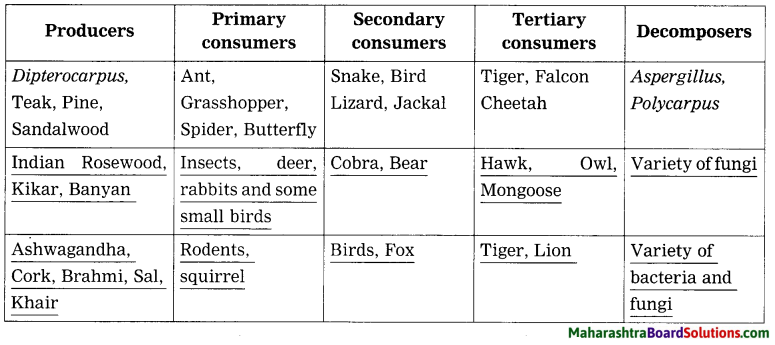
![]()
Question 3.
Observe such ecosystems around you and complete the following chart.

Answer:
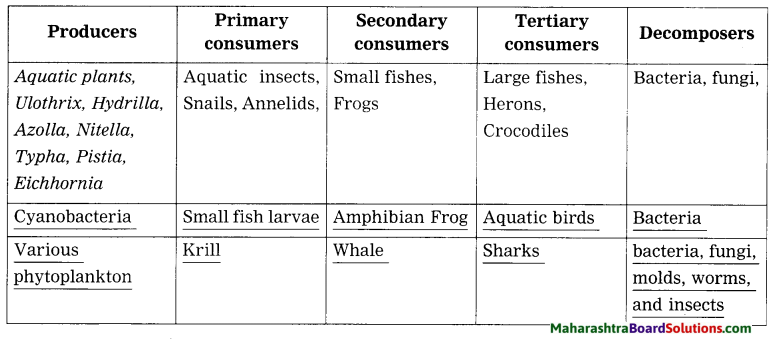
![]()
Question 4.
Complete the table.
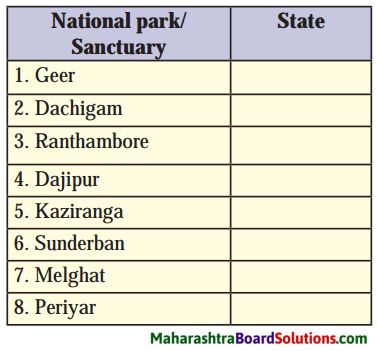
Answer:
| National Park/Sanctuary | State |
| 1. Gir | Gujarat |
| 2. Dachigam | Jammu-Kashmir |
| 3. Ranthambore | Rajasthan |
| 4. Dajipur | Maharashtra |
| 5. Kaziranga | Assam |
| 6. Sunderbans | Bengal |
| 7. Melghat | Maharashtra |
| 8. Periyar | Kerala |
![]()
Question 5.
Complete the following chart:
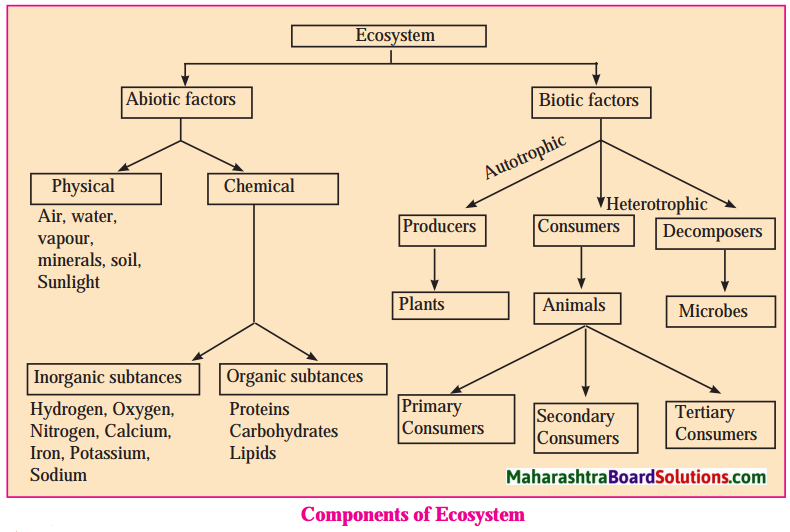
Answer:
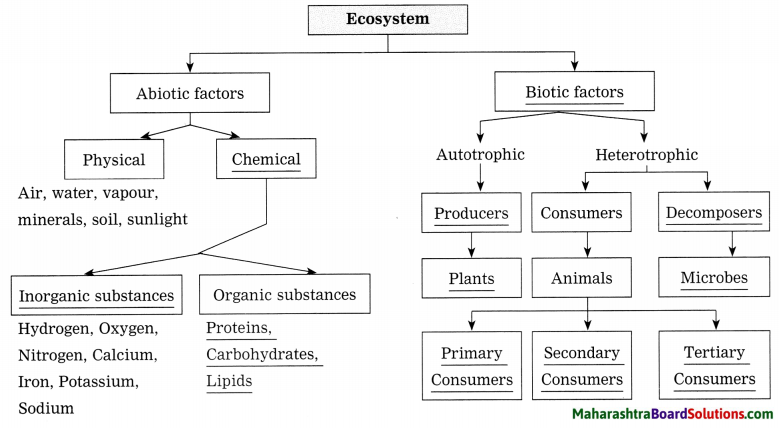
![]()
Diagram based questions:
Question 1.
Correct the following diagram:
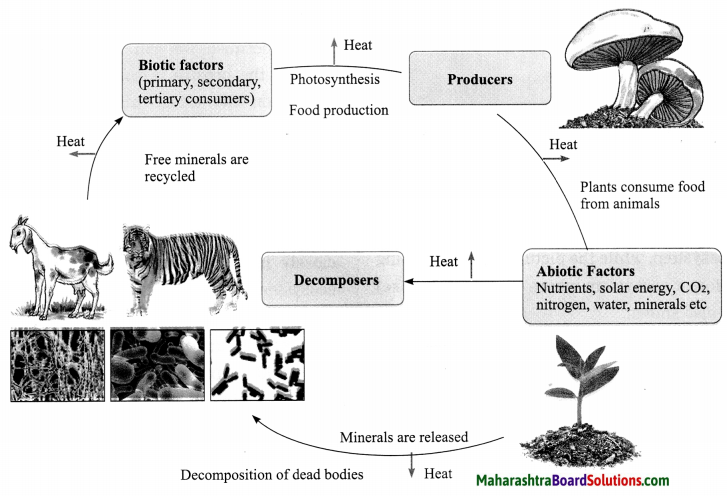
Answer:
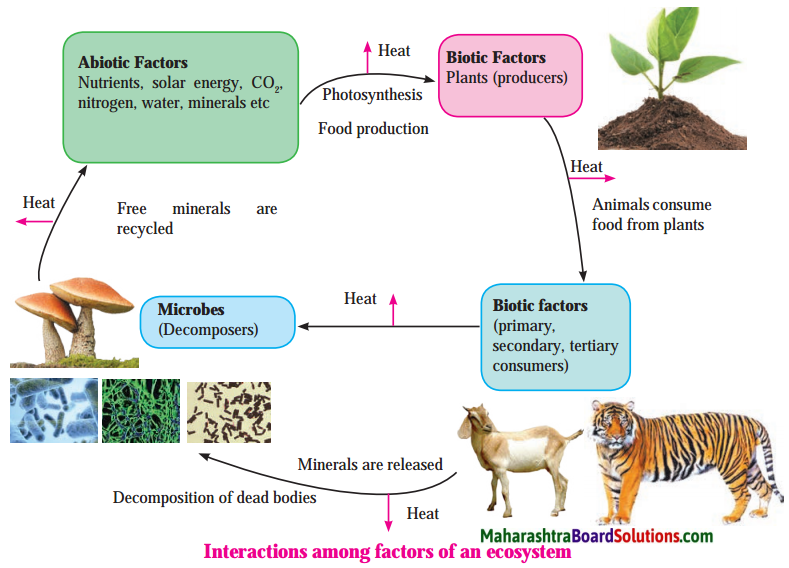
MCQs based on experiment:
Question 1.
Which one out of the following is not biotic factor?
(a) Humidity
(b) Rabbit
(c) Snake
(d) Bacteria
Answer:
(a) Humidity
![]()
Question 2.
Which climatic factor is causing migration of the birds in certain regions of the earth?
(a) Humidity and rainfall
(b) Ambient temperature
(c) Amount of carbon dioxide
(d) Amount of plant matter
Answer:
(b) Ambient temperature
Question 3.
Which abiotic factor mainly distinguishes marine water from the fresh water?
(a) Temperature
(b) Dissolved oxygen:
(c) Salinity
(d) Surface tension
Answer:
(c) Salinity
Question 4.
Why is creek water different from the river water?
(a) Creek water is more polluted than the river water.
(b) Creek water is less salty than the river water.
(c) Creek water is more saline than the river water.
(d) Creek water is less turbulent than the river water.
Answer:
(b) Creek water is less salty than the river water.
![]()
Question 5.
Which land biome shows presence of cacti plants more?
(a) Polar regions
(b) Grasslands
(c) Rainforest
(d) Desert
Answer:
(d) Desert
Projects:
Collect information
Question 1.
What are the possible threats to grasslands?
Answer:
Man tries to use grasslands for agricultural purpose. This transformation causes loss of natural ecosystem. Many animals from grasslands are killed by hunting and poaching. Though now Wildlife Act has protected these animals, many wildlife species are already extinct. There are chances of forest fires which is the greatest threat to grasslands. The global warming may also cause grasslands to become a desert.
Question 2.
Why did Asian Cheetah become extinct in last century?
Answer:
When British ruled India, Asian Cheetah was hunted to a great extent. The kings and British rulers did rampant hunting. The forest lands were also reduced due to encroachment by humans to build their settlements. Dams were constructed. Mega highways, bridges and roads caused loss of habitat for Asian Cheetah. Cheetah needs large thickly forested territory. This was lost due to all man-made activities. All these reasons made Asian Cheetah extinct in last century.
![]()
Question 3.
Observe Asian Cheetah on internet. Describe it.
Answer:
Cheetah is the fastest running feline animal on the earth. Though from Asian regions it is said to be extinct, in African grasslands, its occurrence is still there. But it is endangered animal. By 2016, the global cheetah population is estimated at approximately 7,100 individuals in the wild. Several African countries have taken steps to improve cheetah conservation measures.
Cheetah has a slender body, deep chest, spotted coat. Its head is small rounded and on the face there is black tear-like streaks. It has long thin legs and a long spotted tail. Cheetah in India were tamed during Moghul period for assisting in hunting. Stories about such episodes are commonly told. However, the last Cheetah in India was spotted in Bastar, M.P. in 1948.
8th Std Science Questions And Answers:
- Human Body and Organ System Class 8 Questions And Answers
- Introduction to Acid and Base Class 8 Questions And Answers
- Chemical Change and Chemical Bond Class 8 Questions And Answers
- Measurement and Effects of Heat Class 8 Questions And Answers
- Sound Class 8 Questions And Answers
- Reflection of Light Class 8 Questions And Answers
- Man-made Materials Class 8 Questions And Answers
- Ecosystems Class 8 Questions And Answers
- Life Cycle of Stars Class 8 Questions And Answers
